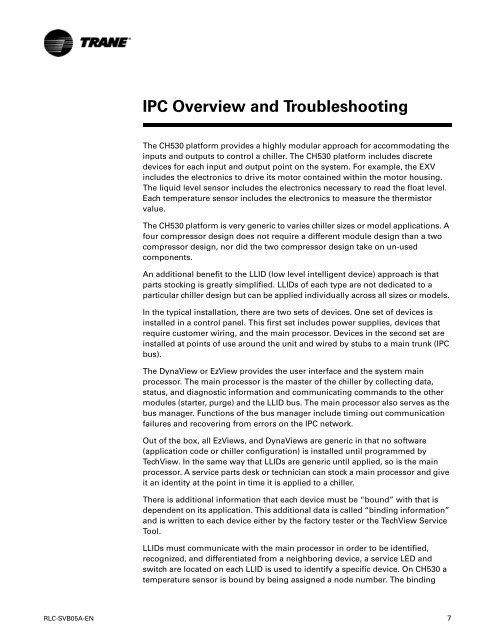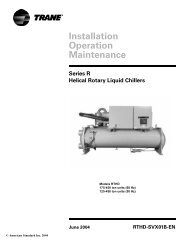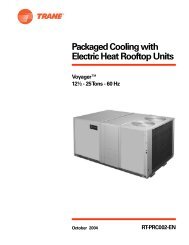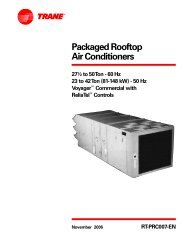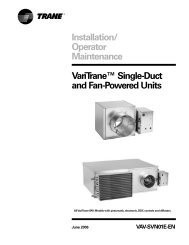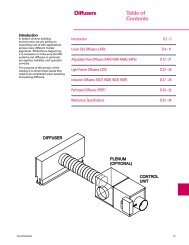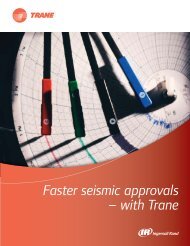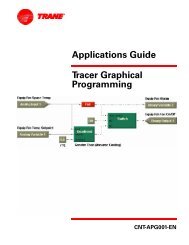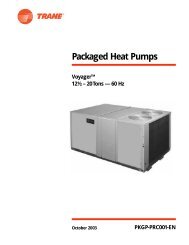RTHD and RTAC - Trane
RTHD and RTAC - Trane
RTHD and RTAC - Trane
You also want an ePaper? Increase the reach of your titles
YUMPU automatically turns print PDFs into web optimized ePapers that Google loves.
IPC Overview <strong>and</strong> Troubleshooting<br />
The CH530 platform provides a highly modular approach for accommodating the<br />
inputs <strong>and</strong> outputs to control a chiller. The CH530 platform includes discrete<br />
devices for each input <strong>and</strong> output point on the system. For example, the EXV<br />
includes the electronics to drive its motor contained within the motor housing.<br />
The liquid level sensor includes the electronics necessary to read the float level.<br />
Each temperature sensor includes the electronics to measure the thermistor<br />
value.<br />
The CH530 platform is very generic to varies chiller sizes or model applications. A<br />
four compressor design does not require a different module design than a two<br />
compressor design, nor did the two compressor design take on un-used<br />
components.<br />
An additional benefit to the LLID (low level intelligent device) approach is that<br />
parts stocking is greatly simplified. LLIDs of each type are not dedicated to a<br />
particular chiller design but can be applied individually across all sizes or models.<br />
In the typical installation, there are two sets of devices. One set of devices is<br />
installed in a control panel. This first set includes power supplies, devices that<br />
require customer wiring, <strong>and</strong> the main processor. Devices in the second set are<br />
installed at points of use around the unit <strong>and</strong> wired by stubs to a main trunk (IPC<br />
bus).<br />
The DynaView or EzView provides the user interface <strong>and</strong> the system main<br />
processor. The main processor is the master of the chiller by collecting data,<br />
status, <strong>and</strong> diagnostic information <strong>and</strong> communicating comm<strong>and</strong>s to the other<br />
modules (starter, purge) <strong>and</strong> the LLID bus. The main processor also serves as the<br />
bus manager. Functions of the bus manager include timing out communication<br />
failures <strong>and</strong> recovering from errors on the IPC network.<br />
Out of the box, all EzViews, <strong>and</strong> DynaViews are generic in that no software<br />
(application code or chiller configuration) is installed until programmed by<br />
TechView. In the same way that LLIDs are generic until applied, so is the main<br />
processor. A service parts desk or technician can stock a main processor <strong>and</strong> give<br />
it an identity at the point in time it is applied to a chiller.<br />
There is additional information that each device must be “bound” with that is<br />
dependent on its application. This additional data is called “binding information”<br />
<strong>and</strong> is written to each device either by the factory tester or the TechView Service<br />
Tool.<br />
LLIDs must communicate with the main processor in order to be identified,<br />
recognized, <strong>and</strong> differentiated from a neighboring device, a service LED <strong>and</strong><br />
switch are located on each LLID is used to identify a specific device. On CH530 a<br />
temperature sensor is bound by being assigned a node number. The binding<br />
RLC-SVB05A-EN 7


